Getting your snowmobile’s track adjusted correctly doesn’t have to be complicated. In this guide, we’ll show you the tools, step-by-step instructions, and troubleshooting tips for all major brands — Polaris, Ski‑Doo/Lynx, Arctic Cat, Yamaha, and more. If you do it right, your snowmobile will run great quickly. Why Track Tension Matters Track tension directly affects […]

Top 7 Illegal Motorcycle Mods: What Riders Need to Know in 2025
Motorcycle modifications allow riders to personalize their bikes for performance, aesthetics, or comfort. However, not all mods are street-legal. Many enthusiasts unknowingly (or intentionally) install parts that violate state laws, risking fines, impounded bikes, or even safety hazards. Below, we break down the top 7 illegal motorcycle modifications based on the latest regulations, enforcement trends, and safety guidelines.
Table of Contents
Top 7 Illegal Motorcycle Mods
1. Full System Exhaust Modifications
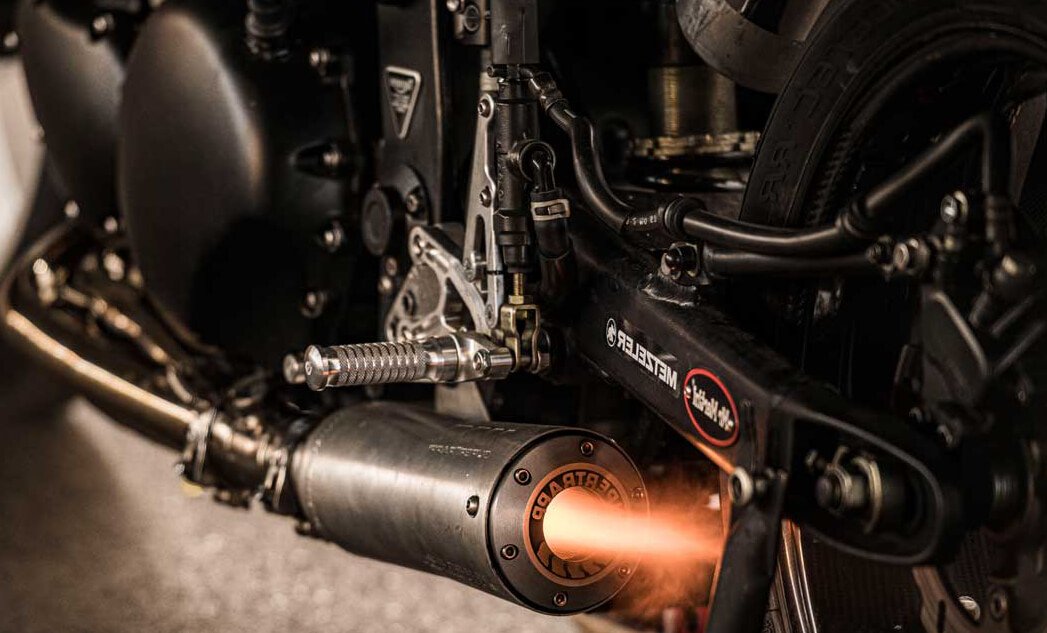
Full system exhaust modifications
Reason
Replacing a motorcycle’s stock exhaust with a full aftermarket system is popular for boosting performance and sound. However, noise and emissions regulations make many of these mods illegal. For example, California’s Vehicle Code restricts exhaust noise to 95 decibels under testing conditions. Similarly, non-compliant systems may bypass emissions controls, violating the Clean Air Act in states like California, New York, and Texas.
Enforcement Risks
Police often target loud exhausts during traffic stops or noise complaints. In 2025, California’s AB 2111 expanded penalties for license plate alterations linked to toll evasion, but officers also use noise violations to flag modified exhausts. Penalties range from fines (100–1,000) to mandatory reinstallation of stock parts.
Legal Alternatives
Opt for CARB-compliant or “for off-road use only” exhaust systems.
2. Tall Tidy (Fender Eliminator Kits)
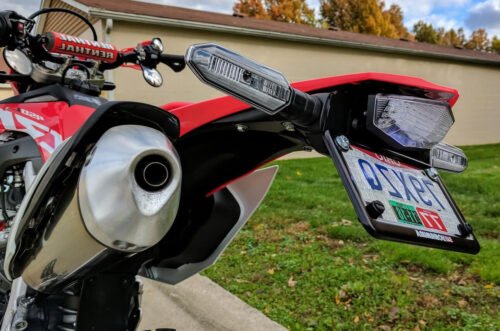
tall tidy
Reason
Fender eliminators remove the bulky stock rear fender for a cleaner look. However, many kits relocate or eliminate license plate lights or reduce the plate’s visibility. States like California and New York require plates to be clearly visible, illuminated, and free of obstructions.
Enforcement Risks
Police frequently cite riders for obscured plates, especially with vertical or angled mounts. California’s AB 2111 (2025) explicitly prohibits altering a plate’s reflective coating or angle to evade automated cameras16. Penalties include fix-it tickets or fines up to $250.
Legal Alternatives
Choose fender eliminators that retain OEM lighting and comply with your state’s plate positioning rules.
3. Removing Turn Signals
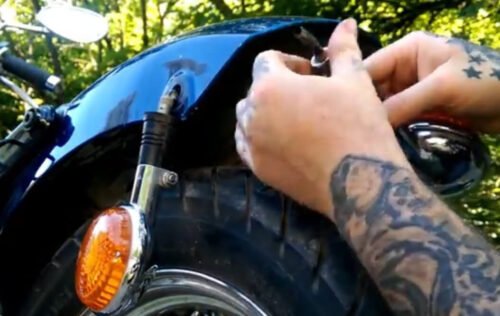
remove motorcycle turn signals
Reason
Motorcycles must have operational front and rear turn signals in most states. Removing them or installing hidden signals (e.g., integrated into mirrors) violates visibility laws. For example, Texas requires signals to be visible from 500 feet away.
Enforcement Risks
Officers often issue citations during routine checks. In 2025, California’s AB 3085 expanded vehicle impound rules for bikes used in sideshows, and missing signals could lead to secondary violations. Fines range from 50–200.
Legal Alternatives
Install LED mini-turn signals that meet brightness and spacing requirements.
4. Mirror Removal
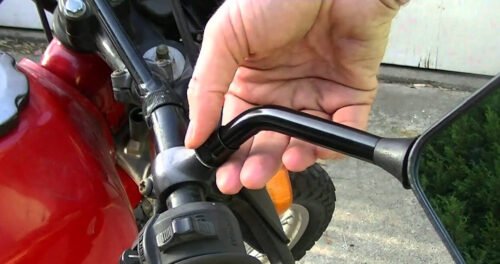
remove motorcycle mirror
Reason
Most states require at least one rearview mirror (typically left-side). Removing both mirrors compromises safety and violates equipment laws. For example, Florida mandates one mirror while California requires two.
Enforcement Risks
Mirrorless bikes attract attention during traffic stops. In states like New Jersey, missing mirrors can lead to “unsafe vehicle” citations, fines, or mandatory inspections.
Legal Alternatives
Swap stock mirrors for lighter bar-end or foldable models. Ensure they provide a 190-degree rear view to comply with state laws.
5. Reflector Removal
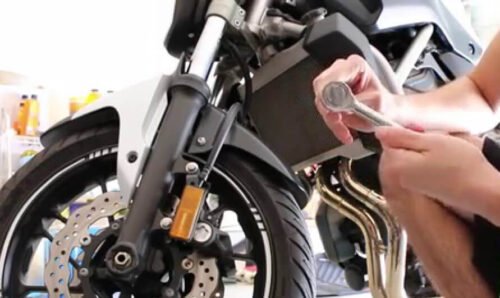
Remove motorcycle reflector
Reason
Reflectors on wheels, forks, and fenders are required by the Federal Motor Vehicle Safety Standards (FMVSS). Removing them reduces visibility to other drivers, especially at night.
Enforcement Risks
While less commonly enforced, missing reflectors can result in “non-compliant equipment” tickets during inspections. States like Pennsylvania include reflectors in annual safety checks.
Legal Alternatives
Use aftermarket reflectors with adhesive backing or integrate reflective tape into custom parts.
6. Illegal Lighting Modifications
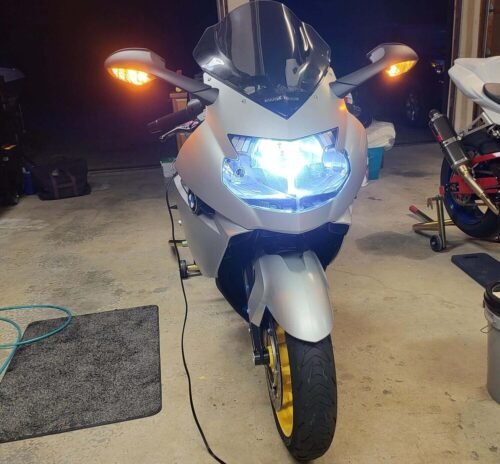
motorcycle lighting modifications
Reason
Modifying lighting includes:
- Colored headlights (e.g., red/blue, which mimic emergency vehicles).
- Underglow kits that distract drivers.
- Smoked taillight covers reduce visibility.
Most states prohibit non-white front lights and non-red rear lights. California’s Vehicle Code § 25950 explicitly bans blue lights.
Enforcement Risks
Lighting violations are easy targets for traffic stops. In 2025, California’s SB 1313 banned devices that interfere with driver monitoring systems, but officers also prioritize illegal lighting.
Legal Alternatives
Upgrade to DOT-approved LED lights with proper colors. For accent lighting, choose white or amber underglow that’s off while moving.
7. Action Cameras on Helmets

Action cameras on helmets
Reason
In California, motorcycle helmets must meet Federal Motor Vehicle Safety Standard (FMVSS) 218 — typically indicated by a DOT (Department of Transportation) certification. While there is no explicit California law banning helmet-mounted cameras, modifications that compromise a helmet’s structural integrity (such as drilling holes for mounts) may render the helmet non-compliant with DOT standards.
Enforcement Risks
Helmet-mounted cameras are not frequently ticketed by law enforcement. However, in the event of a crash, insurance companies may dispute claims if a helmet is found to be altered in a way that compromises its protective function. If the modification invalidates the helmet’s DOT compliance, riders could also be cited for using illegal safety equipment.
Legal Alternatives
Use adhesive mounts or chest harnesses. Brands like GoPro offer low-profile mounts that comply with safety standards.
How to Avoid Legal Trouble
- Research State Laws: Check FindLaw’s state-specific guides for equipment regulations.
- Consult Professionals: Mechanics or dealerships can confirm mod legality.
- Keep Stock Parts: Reinstall OEM components before inspections or resale.
- Prioritize Safety: Even legal mods (e.g., loud pipes) can antagonize communities or increase accident risks.
Conclusion
While motorcycle customization is a cherished part of rider culture, staying informed about evolving laws is critical. In 2025, states like California are tightening penalties for sideshows, exhaust noise, and license plate violations. Always balance personalization with compliance to avoid fines, impoundment, or worse—endangering yourself and others.

Rodney L is a technical writer and product consultant with over a decade of experience in the motor industry. Rodney is a fan of performance machines that run fast and loud and an expert in all things custom. His numerous articles and write-ups are available at our knowledge base. Whether it’s something wrong with your motorcycle or you are building a custom bike, you can trust Rodney’s experience.
Motorcycle riding is all about the sense of freedom, adventure, and thrill of the open road. But come on—being connected when you ride isn't always an easy thing. Whether you're riding with a buddy, navigating traffic in the city, or long-distance riding, effective communication is crucial. That's where the Fodsports T5 and T6 come in, […]
If you're looking for a new motorcycle intercom system this year, Fodsports has something exciting in store. The company has launched two new Bluetooth helmet intercoms: T1 and T1 Pro. Both models bring upgraded features, sleek design, and high-definition audio quality for riders who want to stay connected, entertained, and safe on the road. But […]
Fodsports T1 and T1 Pro: The Newest Bluetooth Intercoms for Riders. Whether you’re cruising on highways, exploring rugged trails, or commuting daily, clear communication is key. Fodsports is thrilled to launch its latest Bluetooth intercoms: the T1 and T1 Pro. Built for riders who demand reliability, versatility, and crystal-clear sound, these devices redefine how you […]
Many riders who aren't so tall or ladies just starting to ride bikes need to pick out the best Motorcycles for Short Riders and Women. They gotta look for three key things: a seat that's not too high up, a bike that's not too heavy, and something that looks good enough to give them confidence. […]
Fodsports FX 60C vs FX30C Pro: What's new techs are the FX 60C bringing to us? Fodsports is a brand worth-mention for helmet communication and video recording. This brand has established itself as a key player with its innovative Bluetooth camera intercom systems. Recently, Fodsports has released a new camera intercom, the FX 60C. How […]
